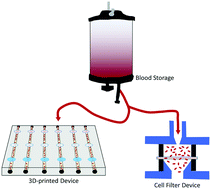A 3D-printed transfusion platform reveals beneficial effects of normoglycemic erythrocyte storage solutions and a novel rejuvenating solution†
Abstract
A set of 3D-printed analytical devices were developed to investigate erythrocytes (ERYs) processed in conventional and modified storage solutions used in transfusion medicine. During storage, prior to transfusion into a patient recipient, ERYs undergo many chemical and physical changes that are not completely understood. However, these changes are thought to contribute to an increase in post-transfusion complications, and even an increase in mortality rates. Here, a reusable fluidic device (fabricated with additive manufacturing technologies) enabled the evaluation of ERYs prior to, and after, introduction into a stream of flowing fresh ERYs, thus representing components of an in vivo ERY transfusion on an in vitro platform. Specifically, ERYs stored in conventional and glucose-modified solutions were assayed by chemiluminescence for their ability to release flow-induced ATP. The ERY's deformability was also determined throughout the storage duration using a novel membrane transport approach housed in a 3D-printed scaffold. Results show that hyperglycemic conditions permanently alter ERY deformability, which may explain the reduced ATP release, as this phenomenon is related to cell deformability. Importantly, the reduced deformability and ATP release were reversible in an in vitro model of transfusion; specifically, when stored cells were introduced into a flowing stream of healthy cells, the ERY-derived release of ATP and cell deformability both returned to states similar to that of non-stored cells. However, after 1–2 weeks of storage, the deleterious effects of the storage were permanent. These results suggest that currently approved hyperglycemic storage solutions are having adverse effects on stored ERYs used in transfusion medicine and that normoglycemic storage may reduce the storage lesion, especially for cells stored for longer than 14 days.

- This article is part of the themed collection: Microfluidics for hematology


 Please wait while we load your content...
Please wait while we load your content...